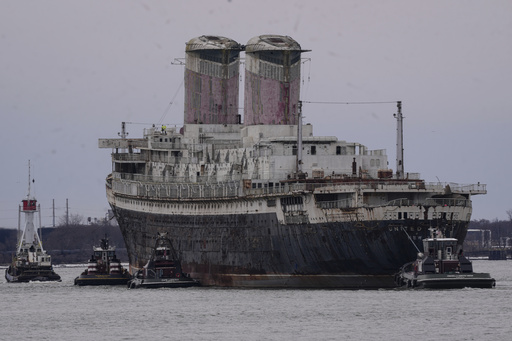The venerable ocean liner, SS United States, embarked on its final journey from the Delaware River waterfront in South Philadelphia on Wednesday, paving the way for its transformation into the world’s largest artificial reef. The ship, measuring 1,000 feet, gained fame for breaking the transatlantic speed record during its inaugural journey in 1952 and is now on its way to Mobile, Alabama. There, preparations will be made before it is sunk into the waters of Florida’s Gulf Coast.
This significant move comes several months after a long-standing rental dispute between the ship’s conservancy and the entity managing the dock was resolved. The relocation of the vessel had originally been planned for last November, but was postponed due to safety concerns regarding its stability as expressed by the U.S. Coast Guard.
Officials in Okaloosa County, located along Florida’s Panhandle, are optimistic that the SS United States will not only enhance the region’s network of over 500 artificial reefs but also serve as a unique diving destination, potentially attracting a significant influx of tourists. This could translate into millions of dollars in revenue for the local economy, benefitting scuba diving shops, charter fishing services, and accommodations.
The estimated total cost for acquiring the SS United States could exceed $10 million. Those involved project that the entire process of cleaning, transporting, and ultimately sinking the ship will stretch over a year and a half.
Once a marvel of American innovation and engineering prowess, the SS United States played dual roles as a passenger liner and a military transport capable of ferrying thousands of troops. Its maiden voyage marked a historic achievement by setting the transatlantic speed record in both directions—averaging 36 knots (over 41 mph). The journey across the Atlantic Ocean took just three days, 10 hours, and 40 minutes, surpassing the previous record held by the RMS Queen Mary by a full 10 hours. Remarkably, the SS United States retains the title for the fastest transatlantic crossing achieved by an ocean liner.
Susan Gibbs, the president of the SS United States Conservancy and the granddaughter of the ship’s designer, remarked on the significance of the vessel, stating, “It will forever symbolize our nation’s strength, innovation, and resilience. We wish her ‘fair winds and following seas’ on her historic journey to her new home.”
After being designated as a reserve ship in 1969, the SS United States changed hands several times among private owners who aimed to redevelop it. However, many found the financial demands or timing of their plans to be insufficient, resulting in the ship remaining idle for years along the Philadelphia waterfront.




